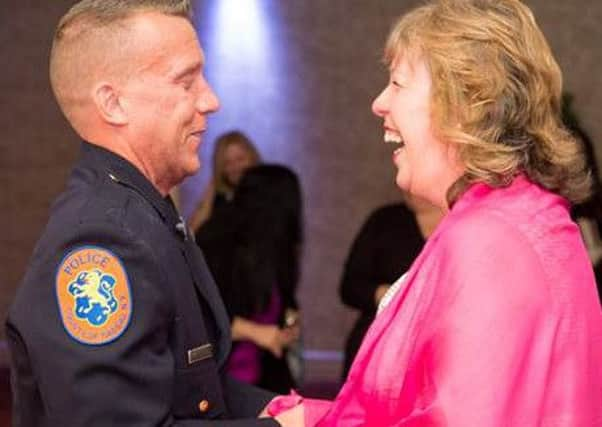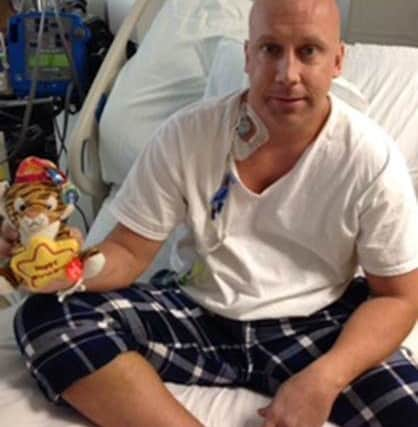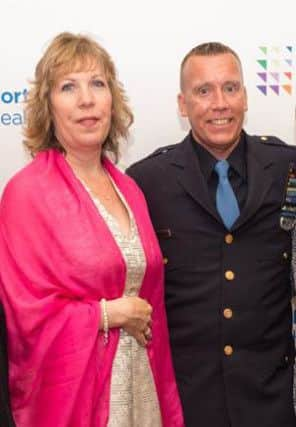VIDEO: '˜She's my hero': NYPD cop meets the Northampton woman who saved his life


Greg Holderson was diagnosed with leukaemia in 2012, which doctors believe was brought on by his efforts on September 11, 2001, when he was a responder to the terror attacks on the World Trade Centre.
In 2014 the policeman was told a bone marrow transplant was his best chance of survival.
Advertisement
Hide AdAdvertisement
Hide AdRemarkably following a worldwide search of donor registers, Northampton woman Sue Harrison was found to be a perfect match, but due to anonymity rules about stem cell donors the two had never met - until now.


On May 10 Sue was invited to the yearly fundraising gala for the Don Monti Memorial Research Foundation in New York, which reunites donors and their recipients.
After the event, Greg, 42, said: “It was an unbelievable moment to finally meet Sue in person and give her a big hug – she’s my hero.
“It’s impossible to find the words to sum up what she has done for me and family; ‘thank you’ just doesn’t seem enough.
Advertisement
Hide AdAdvertisement
Hide Ad“Put simply, if it wasn’t for her I might not be here today.


“I feel lucky to have a donor but I’m even more fortunate to have Sue because she is so lovely. It’s been amazing to share our different sides of the story and to show her the impact her donation has had. She feels like part of the family now.”
Anonymity rules mean transplant donors and recipients can’t reveal their identities to each other for two years, but can exchange letters through blood cancer charity Anthony Nolan.
Greg was dispatched to the World Trade Center in 2001, having only been a police officer for just over a year.
Advertisement
Hide AdAdvertisement
Hide AdHe said: “About 5pm they sent us over to relieve the guys who were there. We saw all the terrible destruction but we had to secure the area and help with the recovery in any way we could.


“Everyone there was covered in dust and debris. It looked like it was snowing, it was just surreal. I was born and raised in New York and it was heart-breaking to see. There were so many innocent lives taken.”
It was 12 years later in 2012, while Greg was working for the Nassau County Police force, when he started to feel unwell and received a blood cancer diagnosis that doctors believed could be linked to his time serving as an officer during 9/11.
“When I first went into the hospital they knew I was a police officer and they asked me if was I down at the World Trade Center on the day and the following days and they told me about the link between the two,” he said. “You see more and more people that were down there getting sick - it’s not a coincidence.”
Advertisement
Hide AdAdvertisement
Hide AdGreg underwent several courses of chemotherapy and went into remission in the summer of 2012. A routine test in the summer of 2013 later revealed his cancer had returned and his best hope was a stem cell donor.


Thankfully, Sue Harrison, 52, from Northampton, had signed up to the Anthony Nolan register in the 80s when she was in her early twenties.
Donors can sign up to the register between the ages of 16-30 but stay on the register until they are 60.
She said: “I signed up after I met my husband Robert, who lost his mother to leukaemia sadly when there wasn’t a register around to help. I just thought why not? It didn’t involve too much effort from me and it seemed like a worthwhile thing to do. I put my card in the drawer and just completely forgot about it.
Advertisement
Hide AdAdvertisement
Hide Ad“It was a real shock to hear I was a match so many years later. I was surprised by how few people actually get a match so it was very special.”
And on meeting Greg she said: “It was very emotional to meet Greg, I can’t imagine what he’s seen and been through it just seems so unfair that he got his cancer through helping others.”
Now both Greg and Sue are calling on more people to sign up to the Anthony Nolan register.
Sue said: “There is definitely a stigma around donating. Many people think it’s a painful or invasive procedure - my mum was worried sick, but that’s what mums do. At no time was it painful, it was so easy and I would have done it again all again. Afterward my donation I had a cup of tea and headed home.”